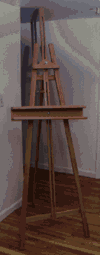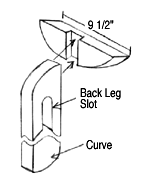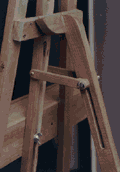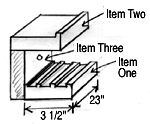

Earlier this year I was vaguely considering purchasing an artist's easel, but a very cursory look in the local art shop soon put a stop to this idea: easels are expensive! Quite why they cost so much is beyond me as they are a very simple construction (let's face it, the average easel consists of three sticks for legs, with a couple of horizontal pieces to hold the artwork up). So, rather than buying one, I decided that it would be far more fun to design and build it.
This easel is built out of cherry, which is a fairly strong wood that darkens with age to a beautiful reddish tone (not that anyone will notice once it has been splattered by dabs of paint).
Tools needed: sander, jigsaw, drill, router (optional)
Wood required:
| Description | Qty | Depth | Width | Length |
| Front legs | 2 | 3/4" | 1 1/2" | 68" |
| Back Leg | 1 | 3/4" | 1 1/2" | 58" |
| Top of back leg | 1 | 3/4" | 1 1/2" | 6" |
| Center support | 1 | 3/4" | 1 1/2" | 70" |
| Bottom cross member | 1 | 3/4" | 1 1/2" | 22" |
| Top cross member | 1 | 3/4" | 1 1/2" | 9 1/2" |
| Front/back connector | 2 | 1/4" | 3/4" | 6" |
| Bottom Rest | 3 | 3/4" | 3 1/2" | 23" |
| Top Rest (1) | 1 | 3/4" | 2 1/2" | 9" |
| Top Rest (2) | 1 | 3/4" | 1 1/2" | 9" |

To begin the construction, first we should build the Center Support. This item should have two slots cut in it to allow the Top and Bottom Rests to move up and down to the correct position. First, mark out to position of the bottom slot. This should be a slot that is 1/2" wide (and should be positioned in the middle of the width of wood) running from a low position of 4" to a high position of 45" from the bottom of the piece of wood. To cut this slot, drill a hole 1/2" diameter at the bottom and top of this marked slot, thus defining the top and bottom of the slot, and then use the jigsaw to carefully cut out the 41" slot. Note that you must be quite accurate with the jigsaw to ensure that the slot is 1/2" wide all along its length. Having cut out this slot, proceed with the higher slot, which runs from a height of 48 1/2" to 66 1/2" from the bottom of the piece. Once both slots have been cut, use the jigsaw to cut the top of the Center Support to a nice, rounded shape. Then sand the slots and top.

Next, prepare the two front legs by also cutting the top of each one to a rounded shape. Then, using the top and bottom cross members, glue the two front legs as described below. Lay out the two legs on the floor, ensuring that the bottom of the two legs are 21 3/4" apart and the top of the legs are 3 1/4" apart. Then, glue and screw the bottom cross member into the two legs, so that the cross member is 9" from the bottom of the legs (Note: Use brass screws as the will look far better). Then glue and screw the top cross member at a height of 55 3/4" from the bottom of each leg. Finally, place a straight rule along the bottom, from the bottom of one leg (outside corner) to the other and draw a straight line across both legs, and then cut off the small triangle of excess wood below each line (thus enabling the legs to stand flat, rather than standing on the inside corners only).

Once done, glue the Center Support onto the middle of the cross members, with the bottom of the Center Support beginning at the lowest point of the bottom cross member. Note: this should be attached to the same side of the cross members as the front legs, thus, all three vertical piece are at the same level.

Next, take the back leg piece and round the top of it into a quarter circle (see diagram right). The, cut a 1/2" wide slot in the back leg, from a height of 5 1/2" from the top of the back leg, to a distance of 12" from the top. This slot will be used to attach a sliding connector between the from and back pieces of the frame. Take the Top of Back Leg piece and curve each end. The cut a 1/4" deep groove that is 3/4" wide down the middle of width and attach the back leg (glue and screw). Then, curve the bottom of the back leg, as shown. Finally, attach two brass 1 1/2" long hinges to the Top of Back Leg piece and attach these hinges to the top back support on the front frame (see photo).

Add the small Front/back connectors as shown in the photos, using small brass screws on the sides of the Center Support (keep them loose so that the Front/back connectors can swing freely) and a bolt through the back leg slot. Note that because the back leg is thinner than the front Center Support, it is necessary to glue an additional scrap of wood onto the back end of each Front/back connector. Having done this, the main frame of the easel is complete.

All that is left to do now is the main Bottom Support and the Top Support. To build the Bottom Support, take one of the three pieces of wood and route a number of grooves into one flat side (now Item One -- see diagram). Take a second piece of wood and route out all of the top, except for a thin lip at one side (Item Two). Glue and screw the three pieces together, as shown in the diagram, and then drill a hole through the center of Item three. Place a bolt through this hole, through the main slot in the Center Support and tighten with a wing nut.
To create the Top Rest, shape the larger piece of wood into an interesting shape (see main photo at top), and then attach the smaller, 1 1/2" wide piece to the underside of it. Then drill a hole through the center of the shaped piece and attach (using a bolt and wing nut) to the top slot on the Center Support.
Finally, sand down everything and complete by waxing.